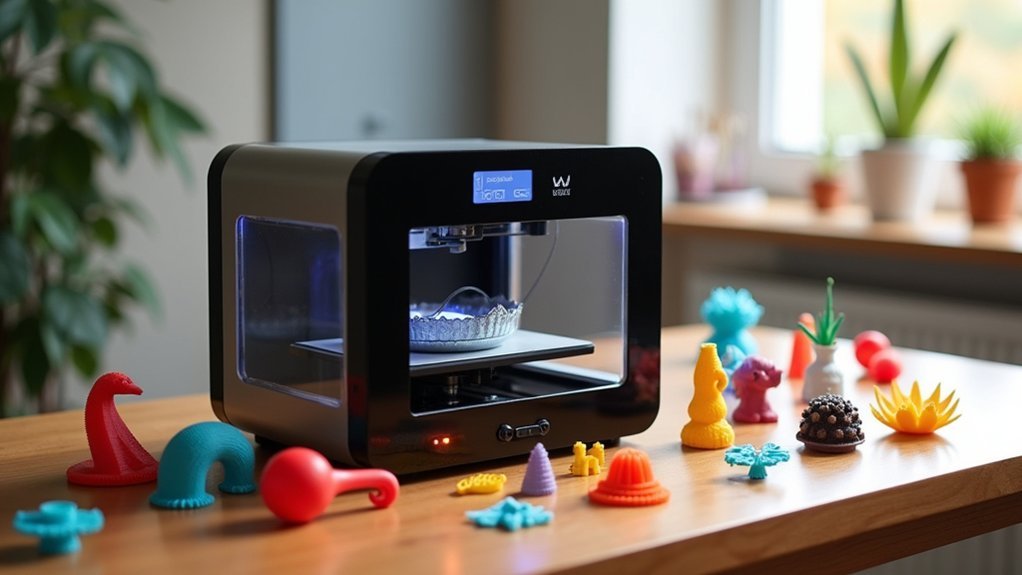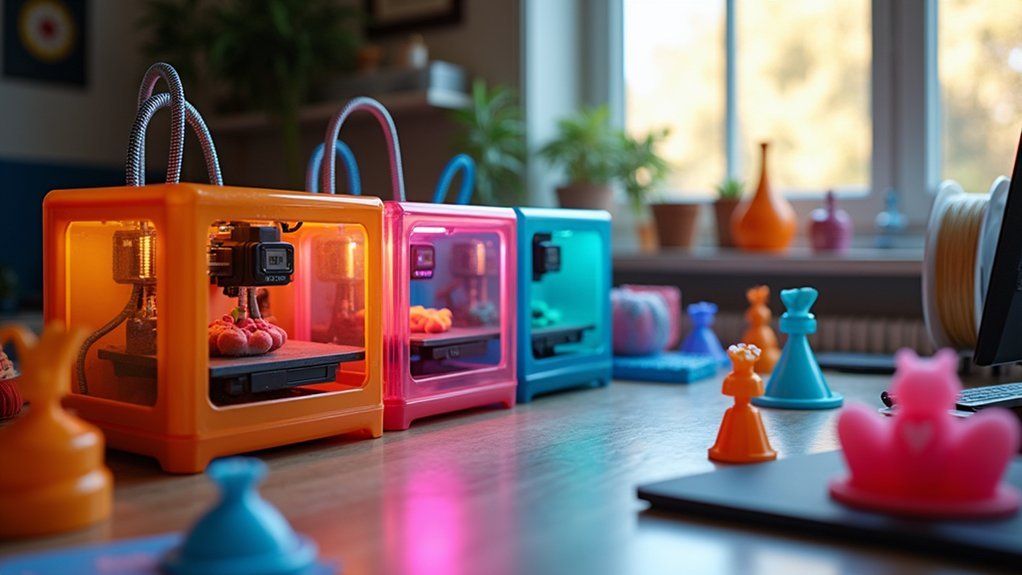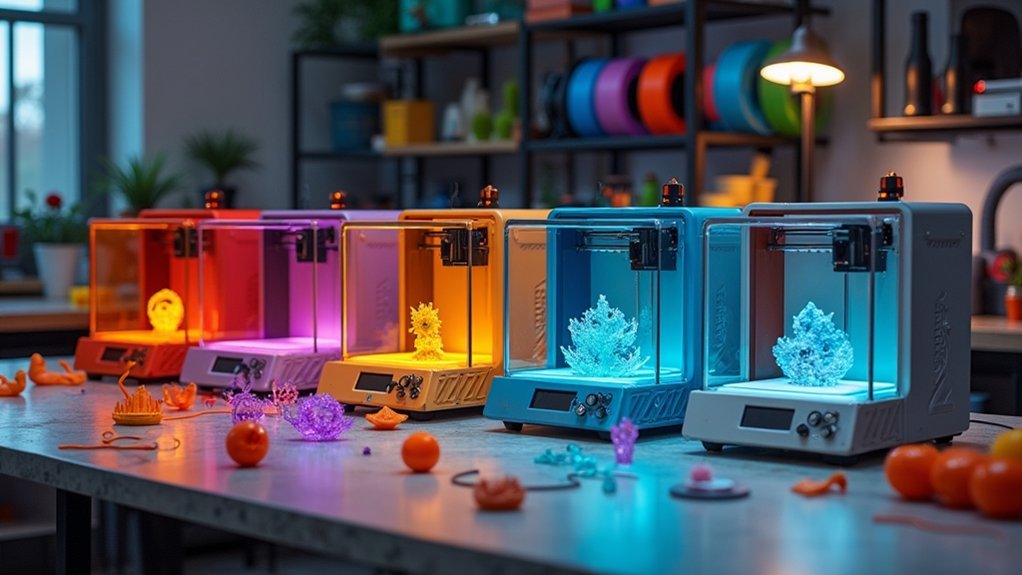You’ll want to evaluate the Elegoo Mars 5 Ultra 9K for its exceptional 9K resolution and beginner-friendly interface, or the Bambu Lab A1 Mini for its intuitive touchscreen controls. The Elegoo Saturn series offers reliable performance with strong community support, while the Anycubic Photon Mono 4K delivers impressive detail at budget-friendly prices often below $150. Look for models with enclosed printing areas, dual linear rails for stability, and UV protection features. The complete guide below covers everything you need to know.
Top Resin 3D Printer Models for New Users

Five standout resin 3D printer models dominate the beginner market in 2025, each offering distinct advantages for new users.
The Bambu Lab A1 Mini delivers exceptional ease of use with its intuitive interface, making your first printing experience smooth and straightforward.
The Bambu Lab A1 Mini’s intuitive design transforms complex 3D printing into an accessible, user-friendly experience for complete beginners.
You’ll appreciate the Elegoo Saturn 4 Ultra’s high-resolution capabilities, perfect for detailed miniatures and small projects.
The Elegoo Mars series offers reliable performance for home use with excellent community support for troubleshooting.
The Mono X2 combines compact design with safety features like UV protection, ideal for your workspace. Remember that liquid resin is toxic and requires careful handling with proper protective equipment during the printing process.
Finally, the Elegoo Saturn 3 Ultra provides 4K resolution printing while maintaining beginner-friendly operation, giving you professional-quality results.
Essential Features to Look for in Beginner Resin Printers
When shopping for your first resin 3D printer, you’ll want to prioritize features that streamline the learning process and guarantee consistent results. Look for user-friendly interfaces with pre-configured profiles that eliminate guesswork. High-resolution LCD screens guarantee detailed prints, while stable mechanical components like dual linear rails maintain consistency. Safety features are non-negotiable—enclosed printing areas protect you from fumes and UV exposure.
| Feature Category | Key Requirements | Beginner Benefits |
|---|---|---|
| Interface Design | Touchscreen controls, intuitive navigation | Reduces learning curve considerably |
| Print Quality | High-res LCD, stable mechanics | Consistent results from day one |
| Safety Systems | Enclosed area, automatic shutoffs | Protection from hazardous materials |
| Post-Processing | Easy build plate removal, cleaning compatibility | Simplified workflow completion |
Consider post-processing compatibility and maintenance requirements to guarantee long-term success with your resin printing journey. Many modern resin printers can achieve layer heights as low as 0.025 mm, providing exceptional detail for miniatures and intricate designs.
Budget-Friendly Options That Deliver Quality Results

Understanding which features matter most helps you focus on the real question: which affordable printers actually deliver those capabilities without breaking your budget.
The Elegoo Mars 5 Ultra 9K stands out at $269-$338, offering exceptional 9K resolution with a generous build volume for batch printing miniatures.
Anycubic’s Photon Mono 4K and Mono 2 4K deliver impressive detail with XY resolutions down to 17 µm, perfect for intricate gaming pieces.
The Creality Halot One Pro balances cost and quality effectively in this price range.
You’ll find mono LCD technology across these models, greatly reducing curing times and boosting productivity.
During promotions, prices can drop below $150, making entry remarkably affordable.
These printers include automatic calibration and user-friendly designs that simplify your learning process. The Elegoo Mars 5 4K earns particular recognition for newcomer design, featuring intuitive controls that make the transition into resin printing smoother.
Safety Protocols and Maintenance Requirements
Resin 3D printing demands strict safety protocols because uncured resin poses serious health risks through skin contact, inhalation, and eye exposure. You’ll need nitrile gloves, respirators, and UV-protective goggles for every session. Always work in well-ventilated spaces and treat resin as hazardous material.
| Safety Equipment | Maintenance Task | Storage Requirement |
|---|---|---|
| Nitrile gloves | Clean vat after prints | Seal containers tightly |
| Respirator mask | Check build plate security | Cool, dry location |
| UV-protective goggles | Inspect UV light sources | Away from children |
Store resin according to MSDS guidelines and cure prints thoroughly before handling. Clean spills immediately with appropriate chemicals. Maintain your printer by calibrating regularly, replacing air filters, and checking components for wear. Keep emergency supplies including eyewash and burn treatment accessible. Remember to pour unused resin back into its bottle using a metal funnel with mesh filter to prevent contamination and maintain resin quality for future prints.
Applications and Projects Perfect for Starting Your Resin Printing Journey

Success in resin 3D printing starts with choosing the right projects that build your skills progressively while producing useful results.
Begin with practical items like USB holders, clip pegs, and phone stands that teach precise printing fundamentals while creating everyday essentials. You’ll develop vital post-processing skills through small tool holders and cable organizers.
Move into artistic territory with miniature figurines and character busts that master detail resolution and transparency techniques.
Don’t skip calibration prints—exposure tests and alignment cones from TableFlipFoundry optimize your workflow and reduce failures.
Expand creativity through decorative household items like customized keychains, coasters, and ornaments that combine utility with aesthetic practice. Consider creating dual purpose amplifiers that enhance smartphone audio while serving as convenient stands for your device.
Experiment with pigment-infused resins and modular components to understand material properties while building problem-solving capabilities through prototype printing.
Frequently Asked Questions
How Long Does It Take to Learn Resin 3D Printing Basics?
You’ll grasp resin 3D printing basics within two to four weeks of regular practice. Expect your first successful prints after several attempts, with post-processing skills developing alongside troubleshooting experience.
Can I Use My Resin Printer in an Apartment or Small Space?
You can use a resin printer in apartments, but you’ll need proper ventilation to outdoor air. Consider grow tent enclosures with extraction fans, avoid bedrooms/kitchens, and guarantee adequate space for safe operation.
What’s the Difference Between Resin and Filament 3D Printing Results?
You’ll get smooth, highly detailed prints with resin but they’re brittle. Filament prints show layer lines but they’re stronger and more durable for functional parts you’ll actually use.
Do I Need Special Software to Operate a Resin 3D Printer?
You’ll need slicer software to convert 3D models into printable layers for your resin printer. Most printers include proprietary slicers, plus you’ll need drivers for computer-printer communication.
How Much Does Resin Material Typically Cost per Print?
You’ll typically spend less than $1 in resin material for small prints. Basic resins cost around $1 per milliliter, while specialty resins like tough or flexible types cost $1.75-$2.25 per milliliter.





Leave a Reply